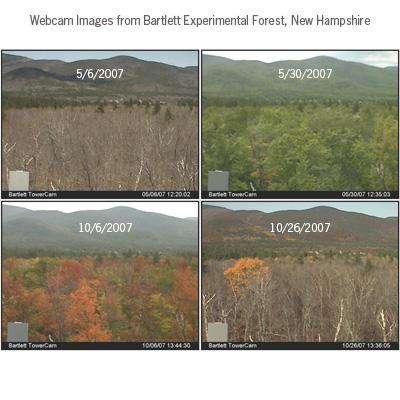Phenological Monitoring across the Northern Forest Using a Network of Digital Webcams

Phenology is the study of recurring lifecycle events influenced by seasonal environmental changes. For hardwood forests, critical phenological events are spring development and autumn coloring of tree foliage, as these effectively mark the beginning and end, respectively, of the growing season. Phenology has proven to be a good indicator of the effects of climate change (e.g., recent warming trends) on natural systems, but improved monitoring of phenology on local-to-continental scales is needed.
NSRC researchers set up a research network that provides automated photo-monitoring of tree canopy phenology across the Northern Forest region. They installed commercial-grade digital webcams on towers at ten established research sites at latitude, roughly, 45°N. Images, recorded every 30 minutes, track spring green-up and autumn senescence based on changes in red, green, and blue (RGB) color channel brightness of each image. At five of the sites, researchers directly link phenology to concurrent measurements of ecosystem processes related to carbon and water cycling. Images from the camera network are presented at the PhenoCam project website (http://phenocam.sr.unh.edu ).
This monitoring study provides a seasonal trajectory of canopy greenness that is tracked from year to year. With data from the webcam network, researchers can follow timing and speed of spring green-up and autumn green-down and the timing and peak intensity of autumn coloration at each site. They can also look at patterns regionally across all ten sites, spanning 10°C in mean annual temperature. This project provides valuable information to forest managers monitoring forest health and to the tourism industry targeting optimal “leaf peeping” conditions.
Download printable version [PDF]
Download full final report [PDF]
